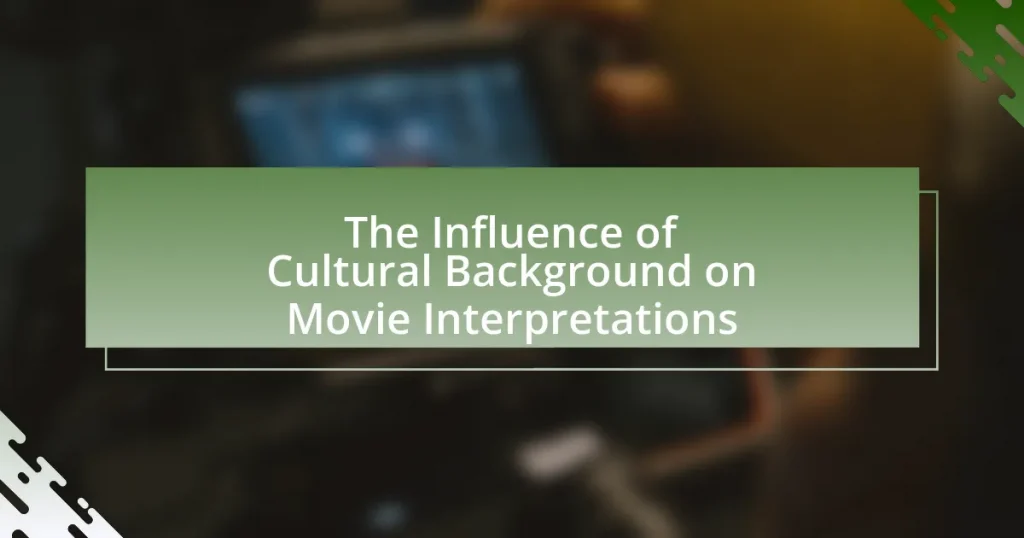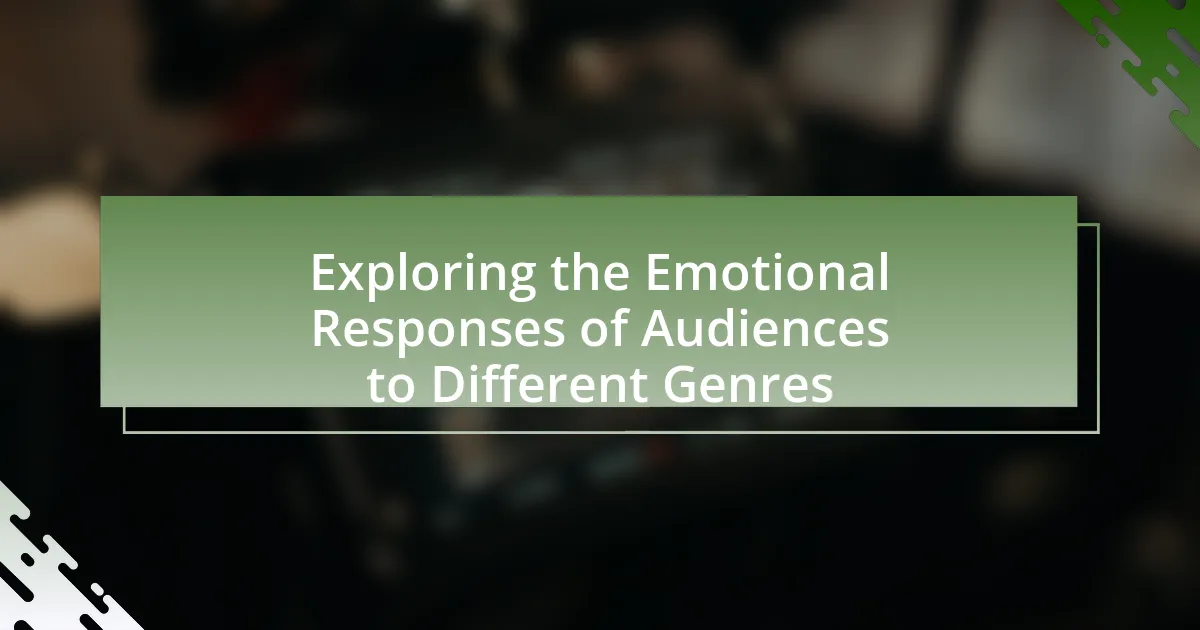The article examines the influence of cultural background on movie interpretations, highlighting how viewers’ perceptions, values, and emotional responses are shaped by their cultural contexts. It discusses key cultural factors such as societal norms, values, language, and historical context that affect audience reception and interpretation of films. The article also explores the interplay between personal experiences and cultural identity in shaping individual interpretations, emphasizing the importance of understanding cultural backgrounds in film analysis. Additionally, it addresses how filmmakers can authentically represent diverse cultures and the benefits of incorporating multicultural perspectives in storytelling.

What is the Influence of Cultural Background on Movie Interpretations?
Cultural background significantly influences movie interpretations by shaping viewers’ perceptions, values, and emotional responses. For instance, individuals from collectivist cultures may interpret themes of family and community in films differently than those from individualistic cultures, often emphasizing group harmony over personal achievement. Research by Hofstede (1980) highlights how cultural dimensions, such as individualism versus collectivism, affect audience reactions to narrative structures and character motivations. This cultural lens can lead to varied interpretations of the same film, as seen in the differing receptions of movies like “The Lion King,” which resonates differently across cultures due to its themes of leadership and responsibility.
How does cultural background shape individual movie interpretations?
Cultural background significantly shapes individual movie interpretations by influencing the viewer’s values, beliefs, and experiences. For instance, a person raised in a collectivist culture may interpret themes of family and community in a film differently than someone from an individualistic culture, who might focus on personal achievement and autonomy. Research indicates that cultural context affects emotional responses and narrative comprehension, as demonstrated in studies like “Cultural Differences in Emotion: A Review of the Literature” by Tsai et al., which highlights how cultural norms dictate emotional expression and perception. Thus, cultural background serves as a lens through which individuals perceive and understand cinematic narratives, leading to diverse interpretations based on their unique cultural experiences.
What are the key cultural factors that influence movie perception?
Key cultural factors that influence movie perception include societal norms, values, language, and historical context. Societal norms dictate what is considered acceptable or taboo, shaping audience reactions to themes and characters. Values, such as individualism versus collectivism, affect how viewers interpret character motivations and plot developments. Language plays a crucial role in understanding dialogue and cultural references, impacting emotional engagement. Historical context provides a backdrop that can alter the significance of events portrayed in films, as seen in how different cultures respond to narratives about war or social justice. These factors collectively shape the way audiences perceive and interpret movies, leading to varied responses across different cultural backgrounds.
How do personal experiences relate to cultural background in film interpretation?
Personal experiences significantly shape how individuals interpret films, as these experiences are often influenced by their cultural backgrounds. Cultural background provides a framework of values, beliefs, and norms that inform viewers’ perspectives, leading them to perceive and understand film narratives differently. For instance, a study by Hall (1980) on encoding and decoding in media suggests that audiences interpret messages based on their cultural contexts, which means that personal experiences rooted in specific cultural settings can lead to varied interpretations of the same film. This interplay between personal experiences and cultural background highlights the subjective nature of film interpretation, where individual histories and cultural narratives converge to create unique viewing experiences.
Why is understanding cultural background important in film analysis?
Understanding cultural background is crucial in film analysis because it shapes the themes, narratives, and character development within a film. Cultural context influences how audiences interpret symbols, dialogues, and actions, leading to varied meanings across different cultures. For instance, a film that portrays familial loyalty may resonate differently in collectivist societies compared to individualistic ones, as seen in the analysis of films like “The Farewell,” which highlights the significance of cultural values in storytelling. This understanding allows analysts to appreciate the film’s depth and the intended messages, ensuring a more comprehensive interpretation that acknowledges diverse perspectives.
What role does cultural context play in storytelling and themes?
Cultural context significantly shapes storytelling and themes by influencing characters, plot development, and moral frameworks. For instance, narratives often reflect the values, beliefs, and social norms of a specific culture, which can alter the interpretation of themes such as love, conflict, and justice. A study by Hofstede Insights highlights that cultural dimensions, such as individualism versus collectivism, directly impact how stories are constructed and understood. In collectivist cultures, stories may emphasize community and familial ties, while individualistic cultures might focus on personal achievement and self-expression. This cultural lens not only affects character motivations but also guides audience expectations and emotional responses, demonstrating that cultural context is essential for a comprehensive understanding of storytelling and thematic elements.
How can cultural background affect audience reception of film messages?
Cultural background significantly affects audience reception of film messages by shaping interpretations, emotional responses, and value judgments. For instance, viewers from collectivist cultures may prioritize themes of community and family in films, while those from individualistic cultures might focus on personal achievement and self-expression. Research by Hofstede (1980) highlights how cultural dimensions, such as individualism versus collectivism, influence perceptions and reactions to media. Additionally, cultural references, humor, and social norms embedded in films can resonate differently across diverse audiences, leading to varied understandings and emotional engagements with the content.

What are the different cultural perspectives in movie interpretations?
Different cultural perspectives in movie interpretations include individualism versus collectivism, varying moral frameworks, and distinct narrative structures. Individualistic cultures, such as those in the United States, often emphasize personal achievement and self-expression, leading to interpretations that focus on character development and personal journeys. In contrast, collectivist cultures, like those in many Asian countries, prioritize community and social harmony, resulting in interpretations that highlight group dynamics and familial relationships.
Moreover, moral frameworks differ significantly; for instance, Western films may present clear distinctions between good and evil, while films from cultures with more fluid moral concepts might explore complex character motivations and ambiguous ethical dilemmas. Additionally, narrative structures can vary, with some cultures favoring linear storytelling and others embracing non-linear or cyclical narratives, reflecting their unique worldviews. These differences are supported by studies in cultural psychology, which demonstrate how cultural backgrounds shape perception and interpretation of media.
How do various cultures interpret common film themes differently?
Various cultures interpret common film themes differently based on their unique social norms, values, and historical contexts. For instance, the theme of family in films is often portrayed as a source of strength in Western cultures, emphasizing individualism and personal achievement, while in many Asian cultures, family is depicted as a collective unit where familial duty and harmony take precedence. This divergence is supported by research from the Journal of Cross-Cultural Psychology, which highlights how cultural dimensions, such as collectivism versus individualism, shape narrative interpretations. Additionally, the portrayal of love varies significantly; in Western cinema, romantic love is often idealized, whereas in Middle Eastern films, love may be intertwined with social obligations and familial approval, reflecting cultural expectations. These differences illustrate how cultural backgrounds profoundly influence the understanding and appreciation of film themes.
What are examples of cultural variations in interpreting love stories in films?
Cultural variations in interpreting love stories in films include differences in themes, character dynamics, and narrative structures. For instance, in Western films, love stories often emphasize individualism and personal choice, as seen in movies like “The Notebook,” where the protagonists’ love triumphs against societal expectations. In contrast, Asian films, such as “In the Mood for Love,” frequently highlight collectivism and familial obligations, portraying love as a complex interplay of social norms and personal sacrifice. These variations reflect broader cultural values, with Western cultures prioritizing personal fulfillment and Eastern cultures emphasizing harmony and duty.
How do cultural norms influence the portrayal of conflict in movies?
Cultural norms significantly influence the portrayal of conflict in movies by shaping the narratives, character motivations, and resolutions depicted on screen. For instance, in collectivist cultures, conflicts often emphasize community harmony and group dynamics, leading to resolutions that prioritize social cohesion over individual desires. In contrast, individualistic cultures tend to highlight personal struggles and self-assertion, resulting in conflicts that focus on personal growth and autonomy. Research by Hofstede (1980) on cultural dimensions illustrates these differences, showing that cultures with high collectivism value group interests, which affects how conflicts are resolved in their cinematic narratives. This cultural lens not only informs the storytelling techniques but also impacts audience reception and interpretation, as viewers bring their own cultural backgrounds to their understanding of the conflicts presented.
What are the implications of cultural background on character development?
Cultural background significantly influences character development by shaping values, beliefs, and behaviors that define a character’s identity. For instance, characters from collectivist cultures often prioritize family and community over individual desires, which can lead to conflicts when faced with personal ambitions. Research by Hofstede (1980) highlights how cultural dimensions, such as individualism versus collectivism, directly affect interpersonal relationships and decision-making processes in narratives. This cultural lens not only informs character motivations but also impacts audience interpretations, as viewers bring their own cultural contexts to the understanding of characters’ actions and growth.
How does cultural identity shape character motivations and actions?
Cultural identity significantly shapes character motivations and actions by influencing their values, beliefs, and social norms. For instance, characters from collectivist cultures often prioritize family and community over individual desires, leading them to make decisions that reflect communal harmony rather than personal ambition. This is evident in films like “The Joy Luck Club,” where characters’ actions are deeply rooted in their cultural heritage and familial obligations. Additionally, cultural identity can dictate responses to conflict, with characters from cultures that emphasize honor and respect displaying motivations that align with maintaining social status and familial reputation. Such dynamics illustrate how cultural context directly informs character behavior and narrative development in storytelling.
What are the effects of cultural stereotypes on character interpretation?
Cultural stereotypes significantly shape character interpretation by influencing audience perceptions and expectations. These stereotypes can lead to oversimplified or biased views of characters, often resulting in misinterpretations of their motivations and actions. For instance, research by Eberhardt et al. (2004) in “Seeing Black: Race, Crime, and Visual Processing” demonstrates that individuals often associate certain racial stereotypes with specific behaviors, which can skew their understanding of a character’s role in a narrative. This effect can perpetuate harmful clichés and limit the complexity of character development, ultimately affecting how stories are received and understood across different cultural contexts.

How can filmmakers consider cultural backgrounds in their work?
Filmmakers can consider cultural backgrounds in their work by conducting thorough research on the cultures they wish to represent, ensuring authentic portrayal and avoiding stereotypes. This involves engaging with cultural consultants, collaborating with individuals from those backgrounds, and incorporating culturally relevant narratives and practices into their storytelling. For instance, films like “Black Panther” have been praised for their respectful representation of African culture, achieved through consultation with cultural experts and community members. Such practices not only enhance the film’s authenticity but also resonate more deeply with audiences from those cultural backgrounds, fostering a greater understanding and appreciation of diverse perspectives.
What strategies can filmmakers use to appeal to diverse audiences?
Filmmakers can appeal to diverse audiences by incorporating authentic cultural representation and storytelling that resonates with various backgrounds. This strategy involves hiring diverse writers, directors, and actors who can bring genuine perspectives to the narrative, ensuring that the content reflects the experiences and values of different communities. For instance, films like “Black Panther” and “Crazy Rich Asians” achieved significant box office success by showcasing underrepresented cultures, demonstrating that audiences are eager for stories that reflect their identities. Additionally, filmmakers can engage in community outreach and focus group testing to understand the preferences and sensitivities of diverse demographics, which can guide the creative process and marketing strategies.
How can cultural consultants enhance film authenticity?
Cultural consultants enhance film authenticity by providing expert insights into the cultural nuances, traditions, and social dynamics of specific communities. Their involvement ensures that the portrayal of characters, settings, and narratives accurately reflects the lived experiences and values of the culture being represented. For instance, films like “Black Panther” benefited from cultural consultants who guided the filmmakers on aspects of African culture, resulting in a more respectful and accurate depiction that resonated with audiences and critics alike. This collaboration not only enriches the storytelling but also fosters greater cultural sensitivity and understanding, ultimately leading to a more authentic cinematic experience.
What are the benefits of incorporating multicultural perspectives in storytelling?
Incorporating multicultural perspectives in storytelling enhances narrative depth and broadens audience engagement. This approach allows for diverse viewpoints, fostering empathy and understanding among different cultural groups. Research indicates that stories reflecting varied cultural backgrounds resonate more with global audiences, as they reflect real-world diversity. For instance, a study published in the Journal of Cross-Cultural Psychology found that narratives featuring multicultural elements improve cross-cultural communication and reduce stereotypes, demonstrating the positive impact of such storytelling on societal perceptions.
What are best practices for analyzing films through a cultural lens?
Best practices for analyzing films through a cultural lens include understanding the cultural context of the film, examining the representation of different cultures, and considering the filmmaker’s background and intentions. Analyzing the cultural context involves researching the historical, social, and political environment in which the film was made, as this can significantly influence its themes and messages. For instance, films like “Parasite” reflect South Korean societal issues, highlighting class disparities that resonate with local audiences while also appealing to global viewers.
Examining representation requires a critical look at how various cultures are portrayed, including stereotypes and authenticity. For example, the portrayal of Indigenous cultures in films like “Avatar” can be analyzed for both its imaginative elements and its potential to perpetuate stereotypes.
Lastly, considering the filmmaker’s background helps to understand their perspective and biases, which can shape the narrative. Directors like Spike Lee often infuse their personal experiences and cultural identity into their work, providing a unique lens through which to interpret their films. These practices ensure a comprehensive analysis that acknowledges the complex interplay between culture and cinema.
How can viewers develop a more nuanced understanding of films from different cultures?
Viewers can develop a more nuanced understanding of films from different cultures by actively engaging with the cultural context, themes, and storytelling techniques unique to those films. This engagement can include researching the historical, social, and political backgrounds of the cultures represented, which enhances comprehension of the film’s narrative and character motivations. For example, understanding the significance of family dynamics in Japanese cinema or the impact of colonial history in African films can provide deeper insights into the characters’ actions and societal norms depicted in those films. Additionally, participating in discussions, attending film festivals that showcase international cinema, and reading critiques or analyses from cultural scholars can further enrich viewers’ perspectives, allowing them to appreciate the complexities and subtleties inherent in films from diverse cultural backgrounds.
What resources are available for studying cultural influences in cinema?
Resources available for studying cultural influences in cinema include academic journals, books, online databases, and film archives. Academic journals such as “Film Quarterly” and “Journal of Film and Video” publish peer-reviewed articles that analyze cultural contexts in film. Books like “The Cultural Politics of Emotion” by Sara Ahmed and “Film and Cultural Studies” by David Bordwell provide theoretical frameworks and case studies. Online databases such as JSTOR and Project MUSE offer access to a wide range of scholarly articles and research papers. Additionally, film archives like the Library of Congress and the British Film Institute house collections that reflect cultural narratives and historical contexts in cinema. These resources collectively support in-depth research on how cultural backgrounds shape movie interpretations.




